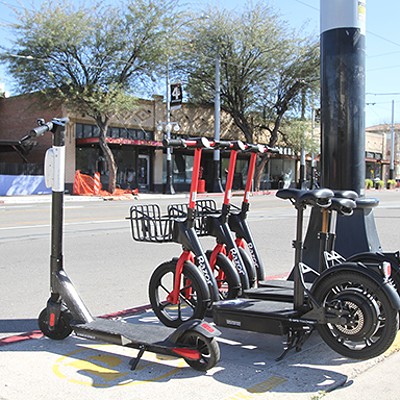When bids for building a new Fourth Avenue underpass, along with rehabilitating the existing underpass, came in last Friday, Granite Construction Company was the sole bidder. Their $31 million proposal was almost $10 million more than the Tucson Transportation Department's estimate.
Granite's Dave Richards says he has never seen price increases like those experienced in the last several months. "They've been at an unbelievable pace," he indicates. Along with higher costs, he also says some materials are in short supply. Plus, Richards adds: "This is a large, complicated job with lots of issues with the Union Pacific Railroad."
Based on the bid outcome, Tucson Transportation Director Jim Glock says his department will look to include construction efficiencies and eliminate some design features, then probably resubmit the project for new bids.
"Clearly, we don't have the money and right now can't do it," Glock says. He also doesn't know how long the work might be delayed past its originally anticipated January 2006 start.
Initially intended to be funded almost exclusively by the Arizona Department of Transportation, during a 20-month construction period, a new, two-lane subway was to be built which would accommodate automobiles, bicyclists and street-rail cars. In addition, sidewalks that comply with the Americans with Disabilities Act would be installed along with two small landscaped plazas at each end of the underpass.
This work was expected to account for 90 percent of the total project cost. The existing, 90-year-old, two-lane underpass would be rehabilitated and converted into a pedestrian-only byway with the remaining money.
When asked before the bidding about the importance of the project--and why so much transportation money is being spent on a project that won't result in any increase in traffic capacity--Glock had two responses. "It's the first phase of the multi-phased effort to provide the linkage of the Barraza-Aviation Parkway across the northside of downtown," he said.
Glock's other explanation for the project was even simpler: "It is my understanding that the existing underpass is the oldest reinforced concrete structure in the state of Arizona, and it needs to be rehabilitated."
Project Manager Brooks Keenan sees several other advantages to the long-anticipated project. "It will bring all the facilities up to current safety standards, along with allowing the historic trolley into downtown," he points out.
Keenan also notes that the inclusion of dual rail lines through the new underpass, a feature which contributes to the total cost by requiring the subway to be wider, is being done in anticipation of Pima County voters next year approving an increase in the sales tax to fund transportation projects.
"The proposed street car running between University Medical Center and downtown will have frequent service," Keenan says. Stating that two rail lines allows for an "ultimate design" to accommodate the street car, Keenan stresses: "The dual tracks in the underpass better provide for that (service)."
Permitting street cars to head north from the Toole Avenue train station up Fourth Avenue was first contemplated more than 90 years ago. When the proposal to dig under the railroad tracks was originally conceived in 1912, the idea of having one traffic lane and one trolley line was considered.
With growing automobile usage, that concept was ultimately rejected in favor of two narrow traffic lanes. The $70,000 underpass was built by a Los Angeles contractor and opened in June 1916.
Back then, in addition to allowing cars to avoid train traffic, the underpass "will be a factor in the revival of the eastern end of Tucson's business district," predicted the Tucson Citizen.
It was almost four years between concept and completion 90 years ago, and it has been even longer this time around. Another similarity is the estimated price of construction. In 1916, the cost of building materials was rising rapidly, which greatly influenced the final figure.
Despite the opening bid setback, Gene Caywood, of Old Pueblo Trolley and the longtime chair of the city's Barraza-Aviation Parkway Citizens Advisory Committee, believes the project must go forward.
"The city needs to sit down, go through the bid and take some things out," Caywood says. "Or they can take some money out of the Rio Nuevo (redevelopment project)."
John Burr, president of downtown's Armory Park Neighborhood Association, agrees with Caywood. "We need the new underpass and have to stabilize the existing one," he says. "Realistically, if the Barraza-Aviation Parkway isn't extended, downtown won't blossom. It's critical to routing traffic around downtown."
As a way to make up the financial shortfall, Burr suggests the city cancel its plans to build a modified grade-separated interchange at 22nd Street and Kino Parkway, which was to be funded with Pima County road bonds (See "Congestion Suggestion," Feb. 17). Instead, he would like to see the $10 million slated for that effort shifted to Fourth Avenue.
"Everybody I know is tickled about the underpass project," Burr says, "so I think the city should find the funds. After all, construction costs are just going to keep doubling every couple of years from here on out."











